Food is one of the best parts of any vacation, and it doesn’t have to blow your budget. Here are my best tips on how to save money on food while traveling.
Want to jump right to the goods? Here you go:
Eat Out: Restaurants, markets etc.
Special Cases: Camping & cruises
Food and travel: Eating memories
Ah, food. It’s one of my favorite things, and it’s definitely one of the things I look forward to most when we travel.
Stop me if I go on too long about that simple chicken we had in Wadi Rum, roasted with onions and peppers over the campfire by our guide. Or those crunchy toasted almonds, chopped and covered in thick local honey and served with juicy strawberries in Tangiers. Or the chocolate candy I got for my fourth birthday on a vacation in southern France…Yup, I remember that.
Food has a way of linking itself to memories, making them colorful and fragrant.

Think about it. You put food right in your mouth. It becomes a part of you! That’s why I think it’s one of the most intimate and immediate ways to experience another place and culture.
Food is one of the most intimate and immediate ways to experience another place and culture.Click To Tweet
How to save money on food while traveling
I also believe that food is one of the easiest line items to stretch in your travel budget. You’ll see how in just a moment.
(You have a budget, right? If you need help getting started with tracking and planning your expenses, try YNAB – You Need a Budget. It has changed how we think about spending money. Get a free month if you sign up through this link!)
However, this is your vacation we’re talking about! So it’s important to find a balance between saving money and enjoying your trip.
I, for one, don’t want to be cooking every meal while I’m on vacation. That’s just like being at home, thank you very much.
But I’m happy to put together our breakfasts and some quick lunches at the Airbnb if that puts eating out at night within our means.
That’s not to say that seeking out affordable food has to deprive you of valuable experiences. Quite the opposite.
Shopping locally or eating at holes-in-the-wall may give you a whole different immersion in and taste of regional culture.

So think of food as a small part of your entertainment budget, too. In fact, you may want to actually combine the two by going on a culinary walking tour or a dinner-and-show package.
How to use this guide
I’ve worked hard to put together a comprehensive list of ways to save on eating while on vacation and present them in digestible, bite-size chunks.
They’re organized into three categories: cooking your own food, dining out, and special cases (such as cruises and camping).
I hope this guide will help you come up with a money saving strategy that suits your wants and needs.
What that implies, though, is that you should do some prep work.
Look up the facilities you’ll be dealing with along your route and at your destination. Is there a kitchen at your Airbnb, a supermarket in walking distance of your campsite, a fridge in your hotel room? Are there any special restaurants you don’t want to miss? What tourist traps do the review sites tell you to avoid?
Then sketch out whether you’ll be bringing your own food and how you’ll transport it, or how much you can afford to spend on your daily meals when you eat out. (Again, a budget is a good idea!)
Before we launch into the details, one more general tip: I’ve found it helpful to have some basic supplies with us wherever we go: reusable containers, resealable bags, and utensils. We use them to carry snacks, pack up leftovers, or eat foods we buy from the store.
EAT IN: COOK YOUR OWN FOOD ON VACATION
If you have the facilities and the wherewithal, cooking some of your meals can save you a lot of money.
Of course that depends a bit on your location. In Vietnam, for example - named the top low-cost location for expats in 2017 - we'd probably just enjoy amazingly affordable Vietnamese food all day, every day. (I haven't been there, but it's on my list.)
Consider these strategies:
1. Bring snacks
We carry lots of snacks when we’re traveling. We can’t always predict when and where we’ll find our next meal, or we’re dependent on someone else’s schedule (e.g. on a flight).
So with little kids in tow, prepacked baggies (these are the best!) of nuts and dried fruit have prevented many an impending meltdown.
I often buy special cookies or chip flavors as a vacation treat, which is usually still cheaper than shelling out for little packs of junk at gas stations or convenience stores.
Here are some foods that don’t require refrigeration and can be turned into easy, no-cook meals and snacks:
- peanut butter, honey (we like these pouches on the go)
- bread (for a couple of days), crackers
- chips, pretzels (this is a kid-friendly mix), dried seaweed
- nuts, dried fruit
- dried meats, such as beef jerky (ideally something natural like this)
- granola or protein bars (Miki loves these)
- cookies and candy (yum!)
- food in cans or pouches: tuna, chicken, olives, spam, vegetables
- boxed broth or sauces
- fresh fruit, such as apples, bananas (for a few days)
(Remember that you can’t bring any liquids, pastes, or gels – peanut butter, honey etc. – on flights, unless they’re in containers holding 3.4 ounces (100 ml) by volume or less.)
2. Bring water bottles
We mostly drink water, so we simply refill our bottles from water fountains, taps, and (clean) springs along the way.
We love our Hydro Flasks. They keep drinks ice cold or steaming hot for hours. Our kids do well with these bottles.
If you’re unsure about water quality at your destination, you may want to consider a filter.
3. Book accommodations with a kitchen
With a kitchen, you can cook all your meals and only eat out when you want.
Airbnb apartments are an obvious choice, but you may also find kitchens in extended stay hotels or at hostels.
Even just a microwave or fridge is helpful. The fridge will chill leftovers from restaurant meals and – if it includes a freezer compartment – refreeze your cooler packs. A microwave lets you heat up those leftovers or prepared meals from the store or home.
If there’s no fridge in your hotel room, ask at the front desk whether one can be brought up.
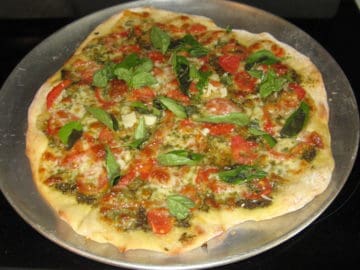
4. Bring your own “kitchen”
No kitchen? Bring your slow cooker (I have this one) or Instant Pot. Really, people do this! You can create simple meals from scratch or heat up prepared foods.
There was that time when I cooked hot pot oatmeal in a fancy Mandalay Bay suite in Las Vegas…
It’s not unheard of, either, to travel with a high-speed blender and whip up fresh breakfast smoothies. (I love mine but haven’t taken it on vacation yet.)
Please note: It’s against the policy of some hotels to bring such cooking implements into the room. I read in the Instant Pot community that this is true for Disneyland properties, for example. Also, please be respectful of housekeeping staff that has to deal with any remaining messes.
So what do you cook in your kitchen, full or improvised?
5. Bring your own ingredients
Bringing your own food on vacation means you’ll have exactly what you like, readily available when you need it, bought at good prices. It’s especially helpful if you have any dietary restrictions
You can pack as little as the fixings for some peanut butter and jelly sandwiches for lunch, and as much as an RV full of food.
I know a family who on camping trips always brought a vacation’s worth of ingredients from Germany to Scandinavia, where at the time food was a lot more expensive.
It all depends on how much space you have for food storage in your suitcase, car, RV, boat etc. Plus, it helps if you have the ability to cool things in a fridge or ice-packed cooler.
Remember that you may run into restrictions in certain countries or states. You’ll likely have your delicious French salami confiscated at the airport if you try to bring it into the US. As a huge agricultural state, California has its own long list of produce that is restricted or forbidden.
6. Bring frozen meals
Do all the prep work before you leave. No wasting your precious vacation time chopping carrots!
Simply pack freezer meals in containers or resealable bags. Cook them in a slow cooker, Instant Pot, pot or microwave, depending on what’s available.
Recipe services such as Once a Month Meals will help you with detailed plans and shopping lists.
7. Bring cultures
Ok, I don’t really know anyone else who does this, but maybe some of you fellow fermenters will come out of the woodwork after reading this?
I sometimes travel with my own cultures. You may remember this from my recent trip report to Tulsa. If I’m going somewhere with a kitchen, I often pack a small container of kefir grains or sourdough in my suitcase (wrapped in about five different zip lock bags).
At the destination, I’ll simply buy milk and add the kefir grains, or keep feeding the sourdough with flour and water. The kefir makes fantastic smoothies, and the sourdough is good for easy crepes, waffles, or bread (if I’m feeling ambitious).
The cultures are a fun gift to share and ensure that we have access to probiotic foods that I know keep us healthy.
8. Have your meal kit delivered
Change your meal kit subscription to be sent to your vacation apartment. You won’t have to worry about shopping.
My favorite service is Sun Basket. They always manage to surprise me with creative combinations and ingredients. Never boring. Plus, I like how hard they work to make their packaging as green as possible. Try them for $35 off your first order:
For vegan options, I love Hungryroot! Get $30 off your first order through this link.
9. Shop locally
Maybe it’s the anthropologist in me, but I love going into regular supermarkets and shops to browse the regional selection of goods. You learn so much about what people eat, the prices they pay, how they shop…
In a rural Louisiana Piggly Wiggly, for example, I was heavily impressed by the aisle-long selection of sausages.
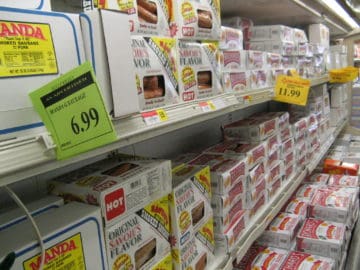
Buy semi-prepared foods that don’t require a ton of work in the kitchen but cost less than delivery. When in doubt, look up your closest Trader Joe’s. (I love their frozen and pre-made meals!)
As an alternative, put together what we call a “room picnic” of prepared foods, such as deli salads, bread, and fruit. Or just do what we did in Leamington, Ontario, and buy a lemon meringue pie for dessert – and breakfast, and lunch. (Lesson: Never buy just a slice of pie. Get the whole thing.)
For extra savings, apply on the spot for a free grocery store membership card, which gives you access to some members-only deals (in the US, possibly other countries).
Or earn easy cashback through the Ibotta app. Get a $10 welcome bonus if you try it out through this link!
Other great sources of local ingredients:
- farmers markets. (See my post on the market in Broken Arrow, OK.)
- roadside stands. Some of my best memories from vacations involve orange juice dripping down my chin. We bought huge bags of sweet, juicy, delectable oranges in Crete and ate them while sitting on a cliff. In California we plucked them off the trees ourselves.
- U-pick farms: Gorge yourself on strawberries while you pick some to take back to the hotel for later.
- bakeries: They may offer reduced prices toward the end of the day.
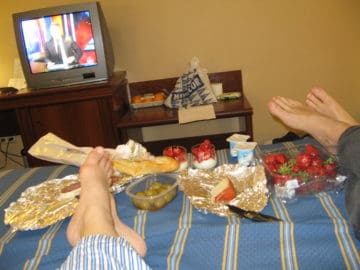
10. Forage
Alright, this is getting a little advanced. You should only forage if you know what you’re doing. Because if you eat the wrong plant or mushroom – well, you may sleep at the hospital instead of the hotel…or worse.
But there are some plants that are pretty easy to learn to recognize, such as blackberries, plantain or dandelions.
Check out this recipe for quick and easy dandelion fritters. Imagine eating those by the campfire!

Falling Fruit is a great site to look for forageable edibles near you.
And here are some good guides to get you started:
EAT OUT
Dining out is a nice break from the usual cooking you do at home. You’ll sample local cuisine (or find a good old hamburger, if that’s what you’re in the mood for), won’t waste time washing dishes, and can get right back to the business of relaxing.
Of course, this convenience comes at a price. Here are some ways to keep that as low as possible:
11. Book accommodations with breakfast (or other meals) included
I love the convenience of not having to think about where my first meal of the day is going to come from.
If you have the right kind of metabolism for this, fill up in the morning. Then you can skip lunch or eat just a light snack and have your next big meal for dinner. (I’m more of an all-day snacker myself.)
If it seems appropriate at your hotel, make a sandwich at breakfast and grab some fruit and pastries to go. Voilà, no need to buy lunch.
Some inns or hotels may also offer a wine reception or afternoon tea with free snacks.

12. Do some research online
Check on sites such as Tripadvisor or Yelp for reviews of restaurants near you and find online menus.
I don’t usually find the hotel folders of restaurant menus very helpful, because they tend to be the pricier, more touristy options.
13. Ask locals where they eat
Chat up your cab driver or someone in the street. Be sure to ask “where do YOU eat?,” not “where can I eat?,” so they know you’re looking for authentic local food, not a touristy place.
They may point you to options you wouldn’t otherwise have considered. Maybe that supermarket on the corner has really good sandwiches. Or that suspect-looking hole-in-the-wall restaurant is actually amazing.
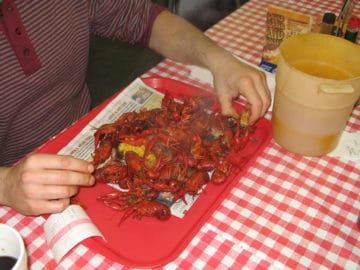
If you’re really lucky, you may end up eating in a local’s home. It has happened to us several times.
Our most memorable meal in Sicily was with Giuseppe and Franca in Casteltermini, after we asked them for some information. They promptly invited us to their house and served us wild fennel with pasta, the local specialty.
Like what you're reading so far? SIGN UP for our newsletter to get more money-saving tips and travel inspiration into your inbox.
14. Leave the touristy areas
Head away from major attractions and transportation hubs, where restaurants tend to be overpriced. (Though some bus and train stations have reasonably priced bakeries and fast food stands. There’s an amazingly cheap crepe stand in the tunnel to the tracks at the train station in Bonn, Germany.)
In the US, for example, there can be really good and affordable establishments tucked away in strip malls. Take the best Thai restaurant in Las Vegas, Lotus of Siam, that you definitely wouldn’t expect right near the nail spa and cell phone store.
Cafes and canteens near universities are also great options. In Wrocław, Poland, for example, we had some really cheap and tasty food at a local student favorite called Bazylia.
15. Go to restaurants for lunch
In the US, lunch menus are frequently discounted, and in Europe you’ll also often find prix fixe (set) menus for a very reasonable price.
This is an especially good strategy if there’s a really fancy place you want to try out but not pay full dinner prices for.

16. Look up happy hours
I’m a big fan of half-price appetizers. This is also a good time to indulge and buy a drink. (Avoiding alcohol will generally save you tons of money.)
17. Find all-you-can-eat buffets
[Due to COVID, many of these are closed.]I’m not a huge fan of buffets. I always feel like I end up eating more than I need and rolling out of there with regrets.
But they’re generally a good value and offer variety for the whole family.
As I mentioned above for breakfast buffets, you may be able to skip a meal after filling up at one of these.
18. Share a plate or order an appetizer
Sometimes it's just nice to get out among people and enjoy the scenery. The food becomes an excuse to sit in a cafe to soak up the atmosphere of the old town plaza or distant mountain views. A drink might do the trick, too.
19. Know drink customs of the country and restaurant
In the US we’re so used to getting free water with our meals that it can come as a surprise that in other countries you’re expected to pay for bottled water. In Germany, for example, requests for tap water will earn you a frown at best, and a flat-out refusal at worst
Also, check whether refills of soft drinks or tea incur an extra charge or are free.
20. Find discounts and deals
Here we come to my favorite part. I love hunting for and stacking deals.
- Check coupon and deal sites, such as Groupon, Living Social, entertainment.com or restaurant.com.
- Make sure to read the fine print very carefully so the conditions (expiration date, days of the week or meal period) match up with your needs.
- Buy gift cards through Raise.com. I love this site because it comes with a 1-year guarantee on the paid-for value. (I've had issues with gift card fraud when I used other reseller sites.) Get $5 off your first order by using my affiliate link.
- Stack these savings (and really any online shopping you do) with cashback from ebates, my current favorite cashback program. The little browser extension even reminds you to apply coupons and activate your savings whenever you’re shopping. Sign up here and get $10 free cash after you make $25 in purchases that earn cash back) For example, I recently earned 17.5% ebates cash back on an already heavily discounted Entertainment coupon book (that’s going to make my favorite local pizza BOGO!).
- Check the restaurant’s social media sites for special offers.
- Find out on what days kids eat free.
- Pick up tourism brochures at rest stops or visitor centers. They often contain coupons.
- Flash your membership cards. Some that may get you discounts: AAA, AARP (or simply being a senior), military, student ID…
- Participate in reward programs such as Skymiles Dining that will pay you back in miles or points later.
21. Get take-out or delivery
Save yourself some time and tip (don’t be cheap and skip the tip completely!) by bringing food to your hotel or apartment.
22. Have a picnic
See the tips above about shopping at local supermarkets. Find a bench somewhere or sit on the grass and watch the world go by.

23. Find street food
Look up food carts and hot trucks. For a good price, you may get more creative food than what you’d find in some restaurants.
How does pork hog braised in Coca Cola with cocoa powder, Thai and Chinese herbs and spices on jasmine rice, pickled mustard greens and boiled egg with pickle Thai chili sauce sound? (Khao Man Gai in Portland, OR)
In countries with, well, less strict food hygiene enforcement, be sure to look for places that follow safe food preparation practices. You don’t want to end up sick. Stands being frequented by many locals is a good sign. They know what’s good and keep the supply rotating quickly.
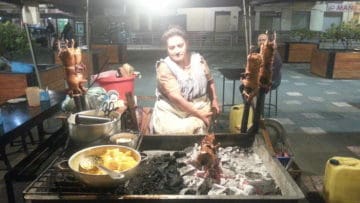
24. Look up small community events
This is something that I know can work in the US and may be feasible in other countries, as well. Find community gatherings such as picnics, little festivals, or fundraising events.
In our area, spaghetti dinners or all-you-can-eat pancake breakfasts (sometimes even with real maple syrup!) frequently serve as fundraisers for organizations and cost something like $7 a person.
Search online or in local papers, or ask someone. Plus, chances are good you’ll end up chatting with the locals.
Want to spend even less? Find events like gallery openings that serve free food and drinks.
25. Eat with locals
If you get lucky, you’ll chat with locals and get an invitation to eat with them (see above). You can also invite yourself through programs like Eatwith or BonAppetour.com.
FOOD ON VACATION: SPECIAL CASES
26. Cruises
I’ve never been on a cruise, so I have no first-hand experience to share, but my understanding is that eating all day (and night) is included in your fare.
You only pay extra for specialty items or specialty restaurants, so avoid those if you don’t want to spend more money. For further details, I defer to the experts.
27. Camping
Tent camping and hiking food deserves a whole post of its own. I can’t claim to be a huge expert in this area (yet), but here are a few tips for now:
- Bring dehydrated meals: I’ve had some great dishes and snacks from this book. And I love my dehydrator! There’s really no reason you couldn't bring these meals to a regular kitchen, by the way.
- For the first evening or even two, I’ve also brought frozen stews that remained sufficiently cold on ice in a cooler. We reheated them over the fire or in a hot pot, if electricity was available.
- RV camping is another area that I have little experience with, but it seems that if you have a small kitchen and fridge, all of the shopping and cooking tips from above apply.
Ok, folks, that’s it! I hope this epically long list will help you plan a food strategy for your next trip.
You may also like:
- Ultimate Pantry Challenge Guide: Eat up and Save Money
- How to Prevent Tick Bites and Protect Yourself from Lyme
- Favorite Things for July 2018
- 7 Things to Do with Kids in Tulsa, OK
And remember to sign up for these sites before you go! (I’d much appreciate if you’d use these affiliate links – it helps to support this site and doesn’t cost you a dime!)
- Raise.com
- Groupon
- Living Social
- ebates (get $10 free cash after you make $25 in purchases that earn cash back)
- Airbnb ($40 off your first booking of $75 or more)
- YNAB (get one month free)
- Hungryroot (get $30 off your first order)
- Sun Basket (get $35 off your first delivery)
I’d love to hear from you how it went! Post some photos of your room picnics and favorite vacation meals in the Happy in the Hollow Facebook group!
Don't forget to sign up for our newsletter:
Photo credit (featured image): Mariamichelle/CC0

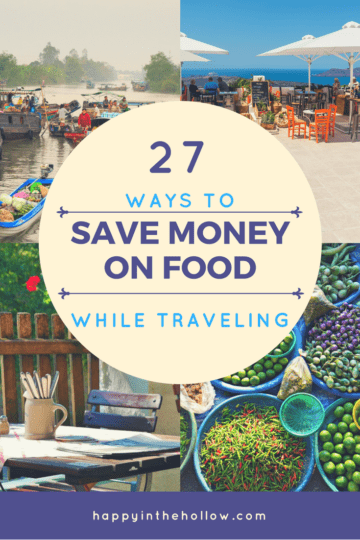



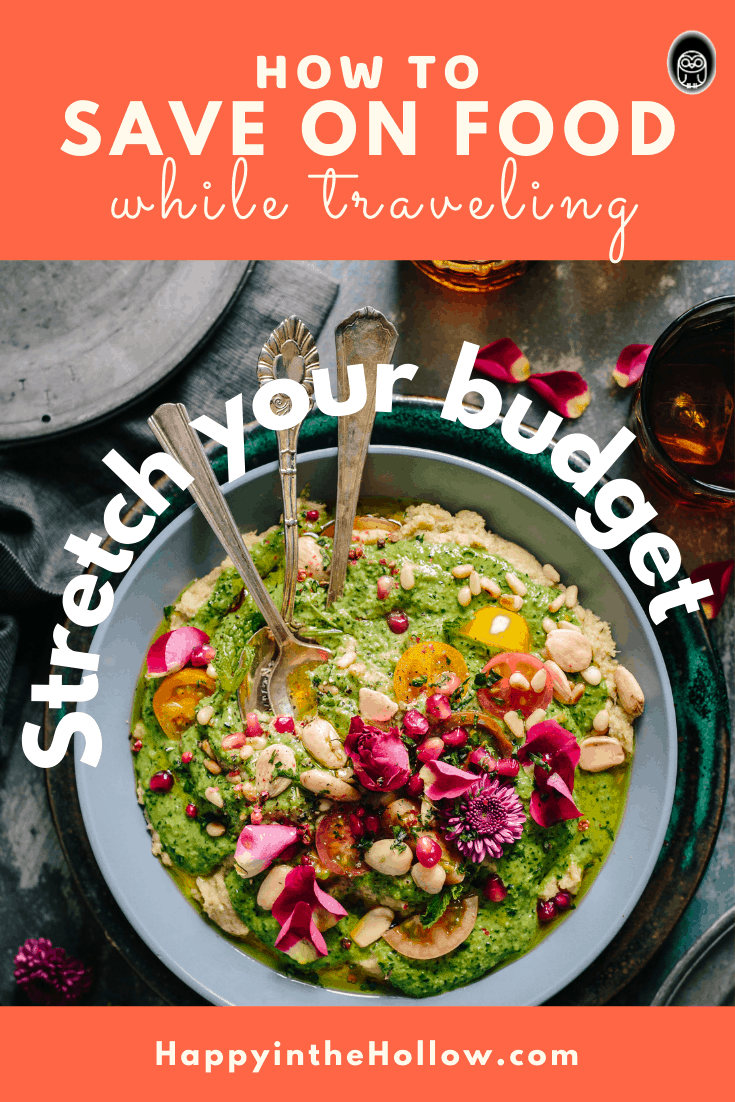
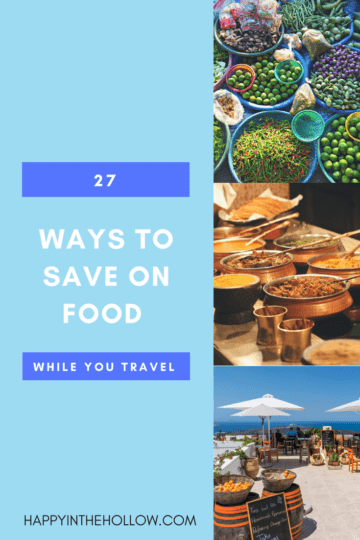
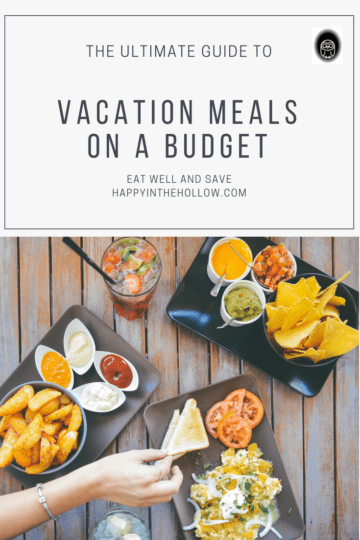
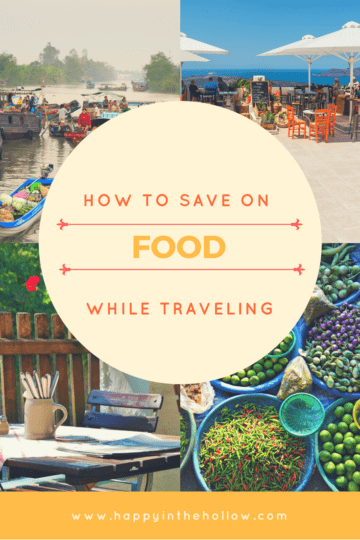
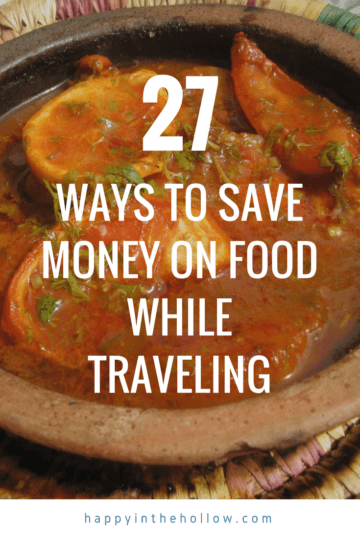


 The Zero-Waste Chef Cookbook: A Review
The Zero-Waste Chef Cookbook: A Review
This is epic. These are great ideas! I just brought my Instant Pot on our road trip and it saved tons of $ and it’s also so nice to come home to already-cooked meals!
Thanks! 🙂 What are your favorite IP recipes on the road?
Finding hotel packages with food included is more common than you think, and it goes beyond just breakfast! I’ve seen “romance” packages that include a dinner and once booked a room where we got a delivery pizza on the first night!
That’s true! I’ve occasionally seen such packages, especially in other countries. I didn’t know some do pizza delivery, though!
These are definitely great ideas; like you said, it’s always a struggle between saving money and enjoying all the food while traveling. I’m going to try some of your tips the next time I travel!
Thanks. I’d love to hear how it goes.
These are awesome tips; I love the crock pot or instapot idea. I’m taking mine the next time we rent a house for vacation!
Thanks! I bet it’ll make things a lot easier. Just throw things in the crockpot in the morning and come back from the beach to dinner… 🙂
This is so awesome. Honestly, a lot of articles with “tips” state the obvious. I LOVED these tips! You have clearly had some awesome experiences abroad. I need to travel with you! lol! Once, in Turks and Caicos, my mom and I survived on crackers, nuts, and cookies and anything cheap because we had no idea how expensive it would be. If only I had seen this in 2015 🙂 🙂
Thank you, Ashley! My travel right now (with kids) is a lot tamer than it used to be, but once they’re a little older…
So many great tips! I’m heading out on vacation the first week of June to an (unfortunately) touristy area. We definitely love finding those hole-in-the-wall spots to save some money and usually eat far better food!
Have a great vacation!
I love all you can eat buffets (even though I’m always overeating at these). Also, I always bring snacks when I’m on the road. I agree with you – that really is a good way to safe money.
Lovely post!
Best,
Claudia
http://thatsmeonline.net
Many thanks, Claudia!
These are awesome tips! And you are right about cruise ships. It’s truly a foodfest!
Thanks, Jennifer! I hope someday I’ll go on a cruise to see for myself.
Great blog post! My best strategy is plan, plan, plan! When we take the family anywhere overnight, I plan the meals, including which one’s we’ll eat out, and then pack the food. Our favorite simple meal (for example when visiting museums in D.C.) is raisin or blueberry bagels with peanut butter. No refrigeration needed and it doesn’t crush! We bring fruit, too, and then the kids’ treat is picking out a special drink (too heavy to pack for 5 people). Another favorite “bread” is tortillas, because they pack well and don’t crush. We used to serve our kids “monkey tortilla sandwiches”, tortillas, pb and bananas.
Thanks, Hilary! I should add “non-crushability” to my criteria for packing food. So very true. I’m adding “monkey tortilla sandwiches” to my list for the next road trip.
In the Room Picnic photo from Madrid, it that an analog, cathode ray tube television? It looks like it is a model from circa 1995. When was that photo taken? Hotels still rent rooms with those old style TVs? I could believe that in some place but am surprised that it would happen in Madrid.
Other thoughts:
Long trips are not conducive to carrying frozen food. Not just the travel time but if you are on the vacation for weeks, the volume of frozen food you need to carry make it too much of a hassle. I would think this would be the case for an InstantPot. Much of this depends on whether you are travelling by car vs. airplane, cruise ship, passenger train, etc.
I assume kefir grains and sourdough yeast are not allowed as airline carry-on.
The farther from home you travel, the more likely the local cuisine will be different. Much of the fun of travelling to far away places is derived from eating food that you wouldn’t eat or couldn’t find at home. That desire renders many of your suggestions as counterproductive to one of the major goals of the trip.
You sound like you know something about TVs. The picture was taken in 2008, so a decade ago.
I definitely suggest picking and choosing which of these many suggestions work best for any given trip. Frozen food in transport will only stay safe for a day or two, depending on temperatures and your cooler.
It’s all about balance. Personally, I like sampling local cuisines as much as my budget allows. But if you’re headed to a cabin at a campground a couple of hours away for a week, I could see bringing a bunch of frozen pre-made meals to stick in the fridge and put in your Instant Pot at the end of the day. Whatever floats your boat! It’s good to have choice.
I found these tips about what to carry in your backpack very helpful! https://www.chicagogrouptravel.com/post/10-items-that-save-you-money-while-traveling
These are all great ideas. The one that’s super obvious that one should think about is leverage your credit cards in all these 3 main options. If you’re buying at local supermarkets use Amex Preffered (6% groceries & 3% has) and Chase Saphire Preferred which has no foreign feed and gives you 3% at restaurants. In addition, you get a Priority Pass which gives you access to lounges at a huge number of airports which translates into free food!!!
Excellent point! Thanks. Especially the Priority Pass. I haven’t had an opportunity to try ours yet, but I hope to someday.
What a thorough article!!! I’m loving it. I’m definitely going to clip it Evernote and mark it on Pinterest for future references.
Thanks, Kimberly! I love my Evernote, too. 🙂
It was helpful when you said that you should book accommodations with breakfast. My sister and I are planning on going on a trip. Thank you for these tips about saving money on food while traveling.
I’m glad you find them useful! Thanks for letting me know. And have a great trip.
I would like to add shopping with cash to the list. I have found that since we switched to the cash envelope system for groceries (and eating out) our spending is more under control. I’m a lot less likely to buy things we really don’t need when I’m looking at how much cash is left in my envelope versus using the debit card.
I’ve never used the cash envelope system myself but know others who have had great success with it.
My wife and I are going on a short trip this weekend. We are going to want to eat out a couple of times so that we don’t have to go to the grocery store. I like how you mentioned that dining out can be a nice break.